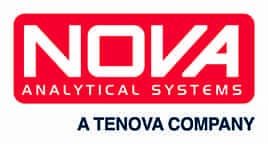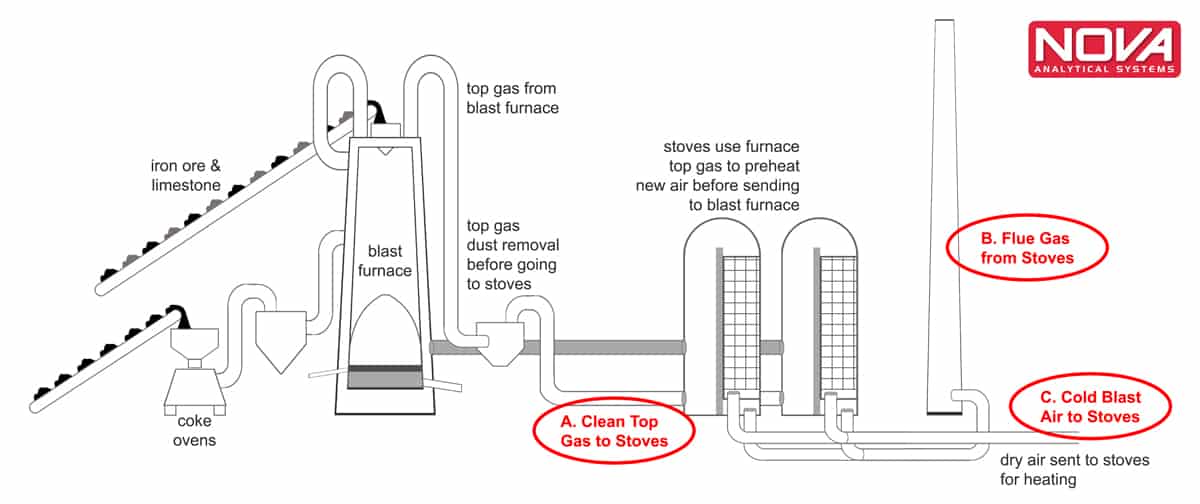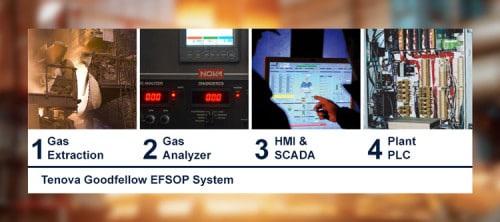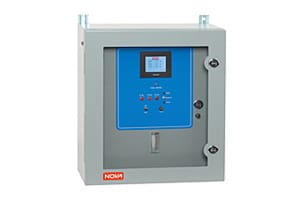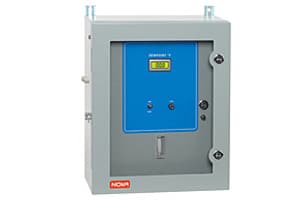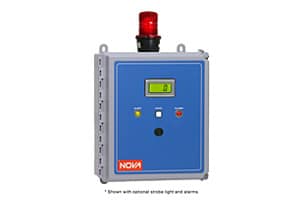Steel-Making and Heavy Industrial Applications
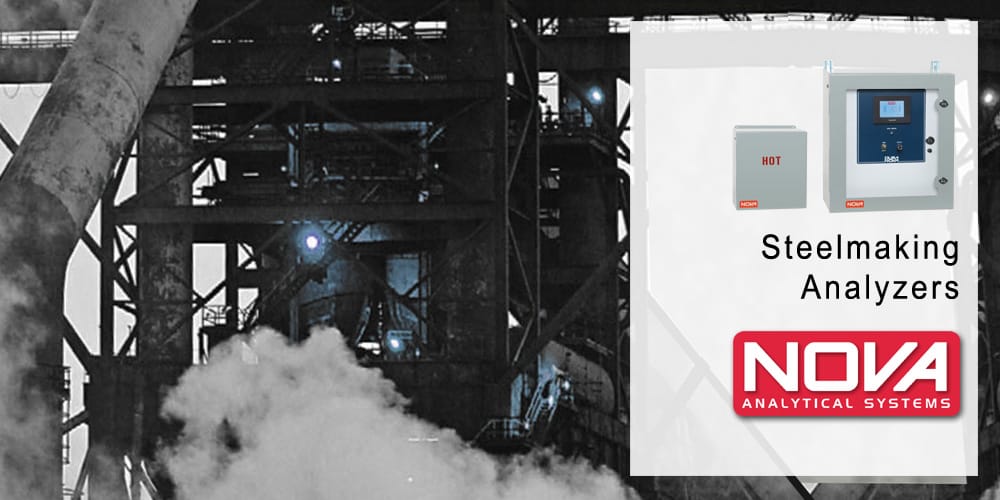
Nova 870 Series Heavy Duty Continuous Analyzers
Discussion
Gas analyzers can be used for monitoring atmosphere gases and flue gases in steel mills and other heavy industries. Steelmaking is a heavy industry that involves the process of producing steel from iron ore, direct reduced iron products, and/or scrap. Basic oxygen furnaces and electric arc furnaces are the predominant means in use today for making steel. The basic oxygen process uses liquid pig-iron from a blast furnace and scrap steel as the main inputs. The electric arc furnace process uses scrap steel or direct reduced iron (DRI) as inputs.
Blast Furnaces
Many steel mills around the world produce iron from iron ore using a blast furnace. The gas that comes out of the top of a blast furnace is generally quite challenging to measure due to its high temperature and particulate content. However, there are a few places in and around the blast furnace process that can be reliably measured with Nova gas analyzers.
From the above diagram, the following opportunities exist for gas analysis:
A. Clean Top Gas to Stoves
The top gas from the blast furnace is cleaned and conditioned before it is used as fuel in the stoves.
After it is cleaned, the gas can be measured for oxygen, carbon monoxide, carbon dioxide, and hydrogen. Calculations such as gas heating value, CO / CO2 ratio, nitrogen (by subtraction), and efficiency can also be done.
Our most popular clean top gas to stove model is the Nova 870 Series.
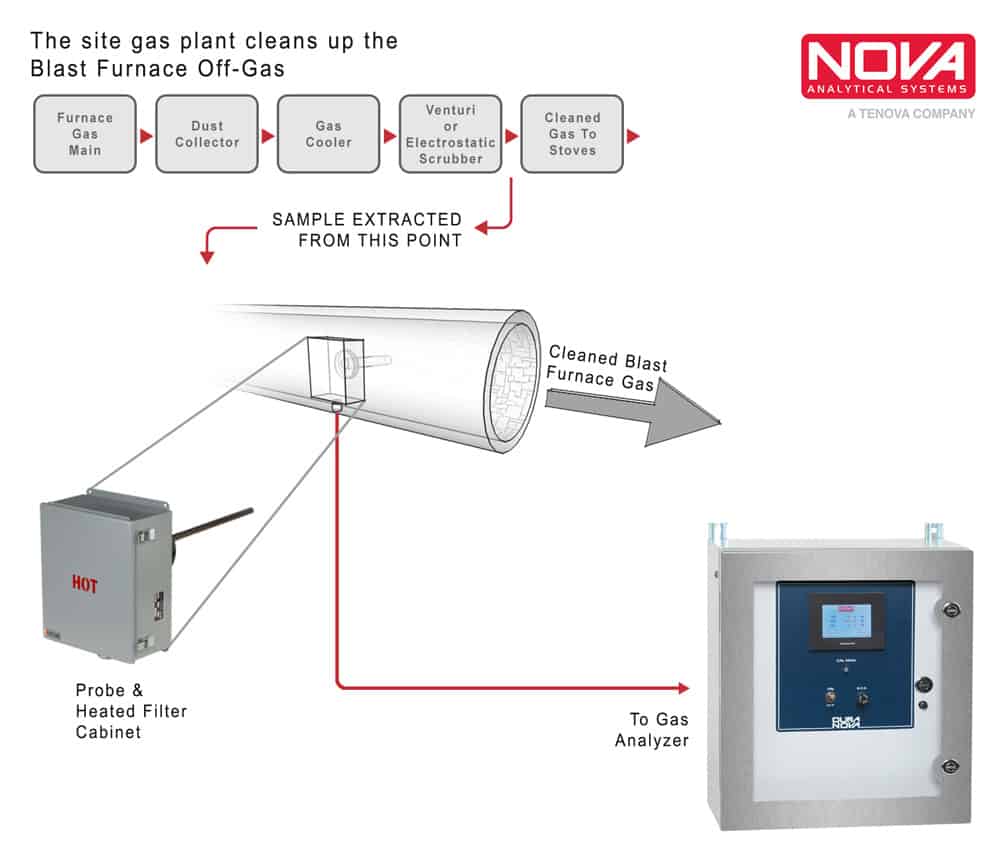
B. Flue Gas from Stoves
After the fuel is burned in the stoves, the exhaust gas can be measured as per normally done so for flue gases. Oxygen, carbon monoxide, carbon dioxide, nitrogen oxides, sulfur dioxide, and stack temperature may all be measured.
Here is another link to the Nova 870 Series. Even though it is not mentioned in the link, we can add NO, NO2, SO2, & stack temp analysis to the 870 Series.
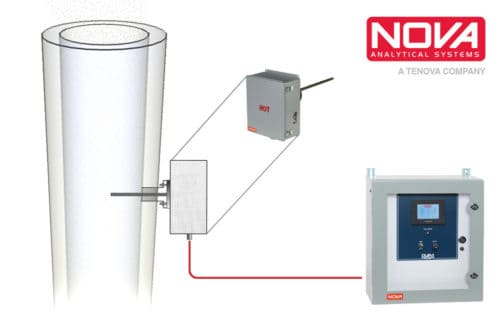
C. Cold Blast Air to Stoves
Blast air is pre-heated in the stoves prior to entering the blast furnace. It is important that the incoming air be dry. To monitor this, a dew point analyzer can be used.
Here is a link to the Nova 257 Series. (For the steel industry, we can provide an ‘industrially hardened’ version of this model.)
Electric Arc Furnaces
Electric arc furnaces (EAF) recycle steel scrap by melting and converting it into high quality steel by using high-power electric arcs. The electric arcs are very hot and are produced between large graphite rods that are extended into the furnace to just above the level of the scrap load. The steel may be processed in batches called ‘heats’, or continuously using specialized production systems such as the Tenova CONSTEEL system.
Tenova Goodfellow also offers the EFSOP system which is used to improve the performance of EAFs. EFSOP stands for Expert Furnace System Optimization Process and is a real-time off-gas based process control system for EAFs.
By measuring and analyzing carbon monoxide, carbon dioxide, oxygen, and hydrogen (CO, CO2, O2, & H2) continuously, EFSOP uses real-time off-gas chemistry to optimize the chemical energy and post-combustion processes within the furnace. In addition, off-gas chemistry information is combined with other process variables to optimize electrical energy usage, carbon & lime usage, slag formation, and system heat load.
Here is another link to more info on the Tenova Goodfellow EFSOP system.
Optimization of EAFs along with DRI intregration (discussed below) represent forward-thinking methodologies for ‘Green’ steelmaking processes that greatly reduce carbon emissions over traditional methods. See here for Tenova’s steel-making product line.
Direct Iron Reduction
Direct Reduced Iron (DRI) plants, directly reduce iron ore to iron without the typical processes involving blast furnaces, coke ovens, basic oxygen furnaces, and other support plants. Dry pelletized iron ore is reacted in a large shaft-style furnace with a hot reduction gas of CO & H2. The heat of the reduction gas is high enough to remove carbon and oxygen, but not high enough to melt the iron. The product is therefore is a solid pellet or briquette instead of a molten liquid.
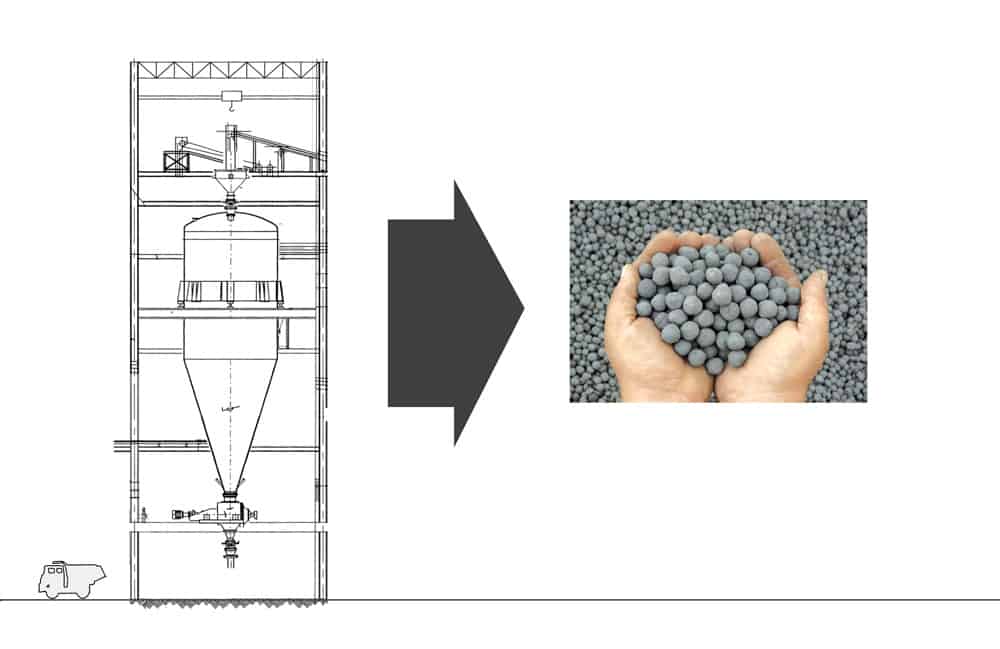
The HYL company started up the world’s first successful direct reduction plant in 1957. Over 40 DR modules have been supplied worldwide since then. HYL is a part the Tenova Group and actively develops projects for direct reduction plants worldwide under the Energiron brand name.
The DRI product can be used in electric arc furnaces (EAF) as a flexible additive to provide additional control over the end product, or where the price and availability of scrap metal requires it.
Mass spectroscopy is used by some steel makers to obtain analysis of gases at various points in the process. The main advantage of this technique is that it is versatile in terms of analytical capability. Numerous types of gases may be measured by a mass spectrometer. However, a basic gas analyzer can be used for the major gases such as oxygen, carbon monoxide, carbon dioxide, methane, and hydrogen.
Two challenges in coupling analytical instruments and steel processes such as DRI are the location and condition of the gas samples. Steel plants are usually sprawling industrial complexes with distances to some sample points being more than 250m (820ft). The condition of the sample is frequently hot, dusty, and under high pressure. For best analysis, the sample should be left intact, while managing the unwanted conditions. In some cases, a primary conditioning system and a secondary conditioning system are required.
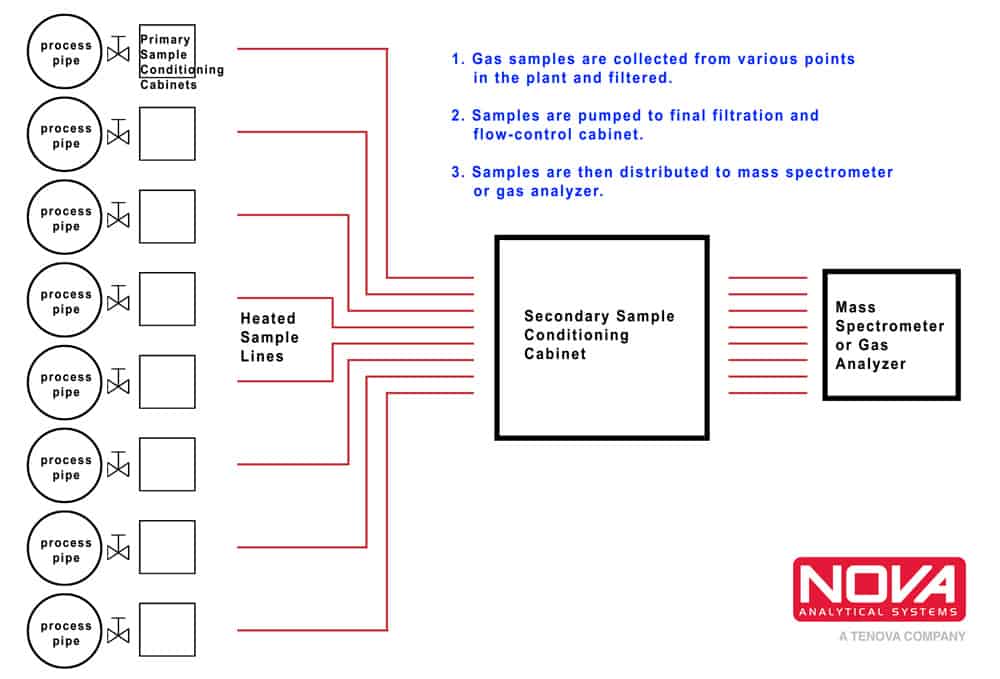
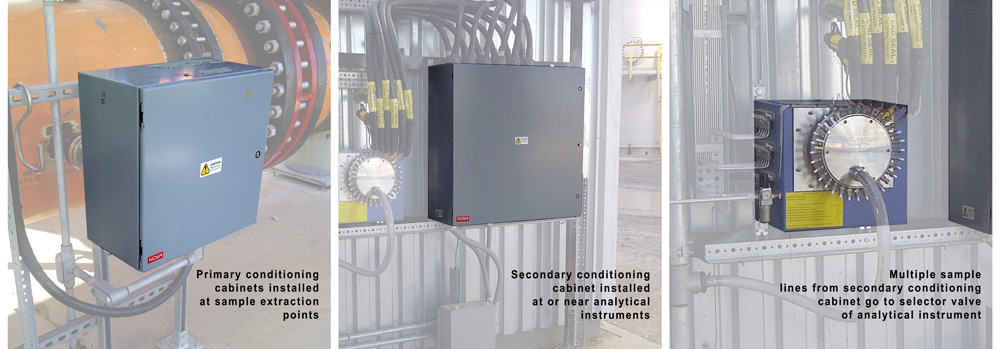
The primary and secondary conditioning systems in the above diagram & photos are not shown in our website catalog. If you are interested in this equipment, you can contact us here. The Nova 870 Series is an analytical instrument that can be coupled to these types of conditioners.
DRI Silo & Bin Monitoring
The DRI product, which is a loose pebble or briquette material, is usually stored on-site in large silos until it is consumed in the EAF. In large enclosed volumes, the DRI material is pyrophoric and can react with air-borne humidity to produce heat & combustion. This necessitates storage under a nitrogen blanket. To ensure that the nitrogen blanket is complete, and that any smoldering events are detected early on, the silo atmosphere may be monitored by a gas analyzer system. For these purposes, it makes the most sense to monitor the silo atmosphere for Oxygen, Hydrogen, and ppm Carbon Monoxide.
Since the DRI product is very dusty, it is important to effectively filter the sample at the extraction point. If there is more than one silo, a probe and filter system must be installed at each silo. However, it is not usually necessary to have a dedicated analyzer at each silo. Multiple silo atmosphere samples may be extracted to sequencer system that will in turn direct the samples one-at-a-time to a common analyzer. The sequencer may be self-controlled or controlled by the site PLC system. The sequencer will provide indication of which sample is currently being measured. This will ensure that any nitrogen blanket deficiencies or smoldering events will be traceable to the particular silo of concern. All of the same measurement principles may also be applied to DRI storage bins for all of the same reasons.
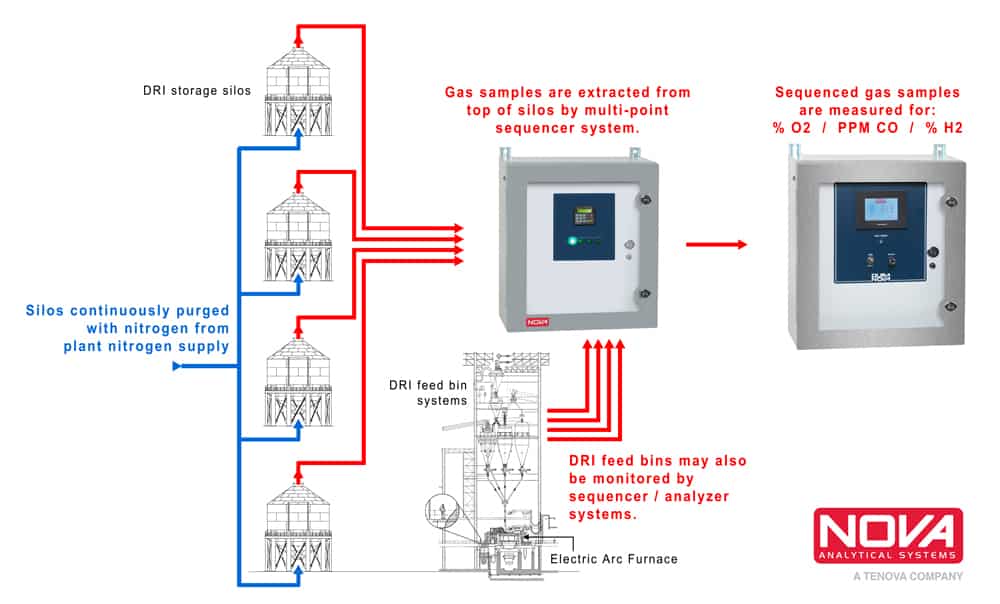
Ambient Air Quality Monitoring
The atmospheres and products of combustion associated with many steel-making operations contain toxic gases that can cause injury or death to nearby staff. This is especially the case in confined spaces and areas where gases are stored in tanks and cylinders. A gas may be directly harmful because of its chemistry, or it may be indirectly harmful because it displaces oxygen.
Non-industrial locations such as laboratories and parking garages also frequently require monitors for indoor air quality reasons.
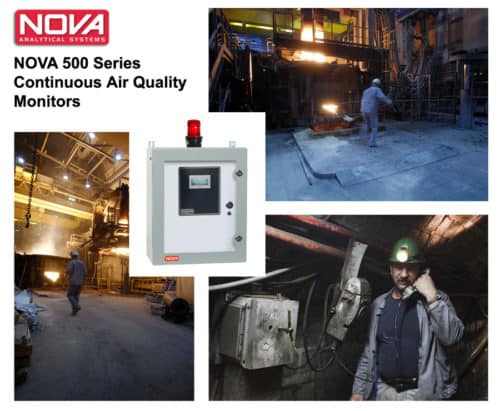
The NOVA 500 Series Monitors can monitor ambient air for various gases. A visible and audible alarm will alert nearby staff that a potentially dangerous condition exists.
Some models can be combined into a single multi-gas analyzer. However, this may not be possible in all cases. Some atmospheres can contain multiple gases that may interfere with analysis of other gases. A monitor can be set up to have internal compensation for some interfering gases, but this is not always effective. Consult with Nova to see if your requirements can be met.
You may also go directly to analyzers for steel-making applications in the product catalog.
Ready for the next step? Please contact our Sales team for more information.
Or to provide us with more information about your application, please complete our Application Questionnaire and our Sales team will follow up with you promptly.

